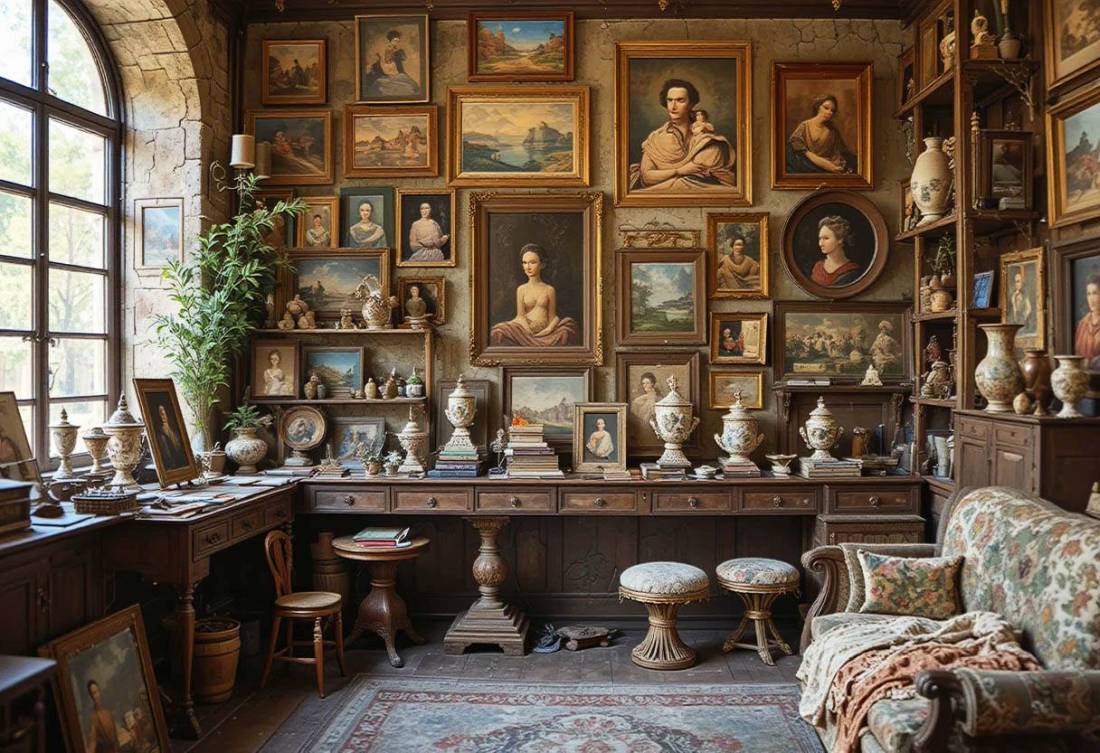
Hidden European Cities with the Best Antique Art, Old Souls, and Stone Streets
Discovering Europe’s Antique Art Capitals in Disguise
Europe’s artistic heritage is written in marble facades, painted on cracked frescoes, and whispered through narrow stone streets. While Paris, Florence, and Vienna bask in global fame, a quieter Europe lies hidden beneath the tourist radar , one where antique shops breathe stories of centuries, where local craftsmen still restore baroque frames, and where every cobblestone seems to echo the past.
If you’ve ever longed to wander through towns where history feels alive, where art is not just displayed but lived, this guide reveals the hidden European cities that remain secret havens for antique art lovers. These are the underrated European cities where old souls will find home , Europe’s antique art capitals in disguise.
1. Lucca, Italy , The Tuscan City of Timeless Grace
Lucca, nestled between Florence and Pisa, is one of Tuscany’s most underrated art treasures. Unlike its more famous neighbors, Lucca’s pace is serene, its walled streets preserving the Renaissance elegance of centuries past.
The city’s antique art scene thrives in its labyrinth of narrow streets lined with vintage shops and artisan studios. Here, you can find everything from 17th-century carved furniture to early Italian religious icons. The Via del Battistero and Via Fillungo are especially known for their antique dealers, each one curating a collection of forgotten heirlooms that reflect Lucca’s noble past.
Lucca also hosts the Antique Market of Lucca (Mercato dell’Antiquariato di Lucca), one of Italy’s oldest and most respected antique fairs, held monthly in Piazza San Martino and Piazza Antelminelli. It attracts collectors and restorers from across Europe seeking genuine Renaissance and Baroque pieces.
Beyond the antiques, Lucca’s medieval walls, Romanesque churches, and terracotta rooftops make it an open-air museum , perfect for travelers who love walking through living art.
2. Ghent, Belgium , The Medieval Soul of Flanders
While Brussels and Bruges draw the crowds, Ghent quietly keeps the artistic flame alive in its cobblestone corridors. Once one of medieval Europe’s richest cities, Ghent remains a sanctuary for antique art enthusiasts who crave authenticity over gloss.
Its historic Patershol district, a web of stone alleys and gabled houses, is dotted with antique stores and galleries that specialize in Flemish paintings, vintage maps, and art nouveau furnishings. A visit to St. Bavo’s Cathedral to see the Adoration of the Mystic Lamb by the Van Eyck brothers is almost a pilgrimage for art lovers , a moment that bridges the medieval to the modern.
The Vrijdagmarkt flea market and the Sint-Jacobs market are local favorites, perfect for discovering old clocks, carved oak chests, and hand-painted ceramics from the 18th century.
Ghent’s charm lies in its paradox , a city buzzing with youthful energy yet haunted by echoes of its Gothic past. It’s where you sip a modern craft beer surrounded by 15th-century architecture , a timeless harmony for the artistic soul.
3. Ljubljana, Slovenia , A Fairytale of Stone and Soul
Ljubljana, Slovenia’s capital, is often called Europe’s best-kept secret , a title it has earned through its unassuming beauty and deep cultural heritage. The city’s old town, framed by the Ljubljanica River and watched over by the Ljubljana Castle, feels like stepping into a painting.
The Ljubljana Antique Flea Market, held every Sunday along the riverbank, is a treasure hunter’s dream. Dealers sell Austro-Hungarian jewelry, vintage postcards, 19th-century glassware, and art deco furniture , remnants of Slovenia’s imperial past.
What makes Ljubljana unique is its fusion of Central European, Balkan, and Mediterranean influences, visible in its architecture and art. The city’s galleries often feature forgotten Slovenian masters, and local restoration studios preserve antique icons with meticulous care.
For a full immersion, wander through Gornji Trg and Stari Trg, where pastel façades hide independent ateliers restoring 18th-century furniture and gilded frames. Every shopkeeper seems to be a storyteller, recounting tales of empires, migrations, and memory.
4. Toledo, Spain , The City of Three Cultures
Perched above the Tagus River, Toledo is an open museum of stone and spirit. Known as the “City of Three Cultures” for its Christian, Muslim, and Jewish heritage, Toledo’s artistry is a tapestry woven across centuries.
The city’s old quarter is a maze of cobblestone streets where antique shops display Damascene metalwork, medieval swords, carved wooden panels, and centuries-old ceramics. Toledo’s artisans still practice Damascening, the art of inlaying gold and silver into iron , a technique that dates back to the Moorish era.
The Toledo Antique Market near the Alcántara Bridge and smaller boutique galleries around Calle del Comercio offer collectors the chance to acquire authentic Spanish antiques rarely seen outside the country.
Beyond shopping, Toledo itself is a living artifact. Its cathedrals, synagogues, and mosques showcase a seamless blend of Gothic, Mudejar, and Renaissance styles , an embodiment of Europe’s layered history.
5. Sibiu, Romania , Transylvania’s Artistic Heart
Few expect to find one of Europe’s richest antique traditions in Transylvania, yet Sibiu delivers with poetic force. Once a Saxon stronghold, Sibiu was a hub of merchants and artisans whose legacy survives in its architecture and antique trade.
The Large Square (Piața Mare) and Small Square (Piața Mică) form the heart of the old city, surrounded by antique shops selling hand-carved furniture, Byzantine icons, embroidered textiles, and vintage clocks from the Austro-Hungarian period.
Sibiu’s ASTRA Museum of Traditional Folk Civilization also preserves centuries of craftsmanship , open-air exhibits of tools, ceramics, and sculptures that mirror Romania’s artistic soul.
Every August, the Sibiu Antique Market Fair attracts collectors from across Central Europe. Beyond the trade, the city’s pastel-colored buildings, steep roofs, and “eyes” peering from attics give it a haunting, old-world charm. Sibiu isn’t just a destination; it’s a portal into a forgotten Europe.
6. Maastricht, Netherlands , The Art Collector’s Sanctuary
Tucked in the southern tip of the Netherlands, Maastricht blends Dutch sophistication with a continental soul. It’s home to TEFAF (The European Fine Art Fair), one of the world’s most prestigious art and antiques events. Collectors and curators from Paris to New York gather here to trade everything from Roman sculptures to 19th-century Impressionist paintings.
But even outside the fair, Maastricht breathes art. In the Wyck district, antique boutiques and art galleries fill 17th-century townhouses. Reestraat and Stokstraat are particularly rich in vintage shops and restoration studios where you might stumble upon Delft ceramics, baroque mirrors, or silver cutlery sets from the Dutch Golden Age.
The Bonnefanten Museum offers a deep dive into both ancient and modern art, while the city’s cobbled quays along the Meuse River evoke a sense of old-world elegance rarely found elsewhere in the Netherlands.
Maastricht’s quiet sophistication makes it one of Europe’s most refined yet underrated destinations for antique art enthusiasts.
7. Kraków, Poland , The Soul of Central Europe
Kraków is where past and present breathe in perfect rhythm. While its Old Town draws tourists, the city’s Kazimierz and Podgórze districts conceal a world of vintage art, Judaica, and forgotten heirlooms.
The Plac Targowy flea market bursts every weekend with stalls offering Polish porcelain, 19th-century icons, vintage maps, and Soviet-era memorabilia , all under the watchful gaze of Wawel Castle.
Kraków’s antique stores along Grodzka Street often feel like time capsules, with baroque clocks ticking alongside faded oil portraits. The Stary Kleparz market is another must-visit for those who love sifting through history’s remains.
But Kraków is more than its objects , it’s an emotion. It’s the flicker of candlelight on Gothic stone, the melancholy violin echoing in an old square. For old souls, Kraków is not just a destination but a feeling of belonging to time itself.
8. Porto, Portugal , The Art of Age and Atlantic Charm
Porto, Portugal’s northern gem, is famed for its port wine , but beyond the vineyards lies a city steeped in antique artistry. Its Ribeira district, a UNESCO World Heritage site, is a maze of tiled façades and steep streets filled with antique dealers and art restorers.
The Rua das Flores and Rua de Galeria de Paris house charming antique shops offering azulejos tiles, maritime antiques, religious sculptures, and 18th-century furniture. The Vandoma Flea Market, held near the Cathedral, is one of the best in Portugal for vintage finds.
What makes Porto special is its patina , the beauty of time itself. Buildings flake, tiles crack, and the entire city feels painted in sepia. The Museu Nacional Soares dos Reis showcases centuries of Portuguese art, while the people themselves embody a deep respect for history and craft.
9. Bratislava, Slovakia , The Forgotten Jewel of the Danube
Often overshadowed by Vienna and Budapest, Bratislava is a compact treasure trove for art lovers. Its historic core, crowned by Bratislava Castle, hides antique shops filled with Habsburg-era furniture, porcelain, silverware, and old coins.
The Hviezdoslav Square Flea Market is a haven for collectors seeking Central European artifacts, while the Old Market Hall (Stará Tržnica) occasionally hosts vintage fairs featuring local artisans and restorers.
Stroll through Panská Street and Michalská Street to discover hidden galleries displaying 19th-century Slovak painters and carved icons. The mix of imperial grandeur and Slavic warmth makes Bratislava a fascinating stop for travelers seeking art off the beaten path.
10. Aix-en-Provence, France , The Whispering Soul of the South
While Provence conjures images of lavender and sunlight, Aix-en-Provence also hides a world of antique charm. Its Cours Mirabeau and Vieil Aix districts are filled with antique galleries, 18th-century furniture dealers, and fine art restorers.
The Aix Antique Market (Foire aux Antiquaires d’Aix) is legendary among French collectors, showcasing everything from Louis XV armoires to Belle Époque jewelry.
The city’s atmosphere , golden limestone façades, fountains murmuring in quiet courtyards , feels untouched by time. Walking through Aix is like living inside a Cézanne painting, with every corner offering a vignette of elegance and history.
Whispers of the Past: Why Hidden Cities Matter
Hidden European cities remind us that art isn’t only in museums , it’s in the walls, the markets, and the memories of those who keep traditions alive. These underrated destinations are not just for buying antiques; they are for feeling the continuity of human creation.
For the antique art enthusiast, each city offers:
Authenticity: Far from mass tourism, you’ll find genuine heritage pieces with real provenance.
Affordability: Hidden cities often sell antiques at a fraction of the price of Paris or London.
Cultural immersion: Interact directly with local artisans, restorers, and collectors.
Atmosphere: Every stone street tells a story , sometimes older than the nation itself.
The Art of Traveling Back in Time
Discovering Europe’s hidden antique art cities is more than a journey , it’s a dialogue with history. From Lucca’s Renaissance elegance to Sibiu’s Transylvanian soul, from Porto’s Atlantic nostalgia to Ghent’s medieval serenity, each destination invites you to slow down and listen to the whispers of the past.
For those who collect not just objects but moments, these underrated European cities are the true antique capitals in disguise , where every street is a gallery, every corner a time machine, and every encounter a brushstroke of living history.




